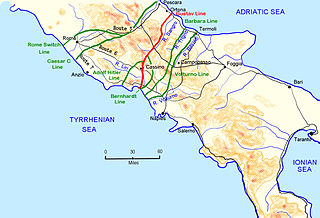
The Winter Line was a series of German and Italian military fortifications in Italy, constructed during World War II by Organisation Todt and commanded by Albert Kesselring. The series of three lines was designed to defend a western section of Italy, focused around the town of Monte Cassino, through which ran the important Highway 6 which led uninterrupted to Rome. The primary Gustav Line ran across Italy from just north of where the Garigliano River flows into the Tyrrhenian Sea in the west, through the Apennine Mountains to the mouth of the Sangro River on the Adriatic coast in the east. The two subsidiary lines, the Bernhardt Line and the Hitler Line ran much shorter distances from the Tyrrehnian sea to just North East of Cassino where they would merge into the Gustav Line. Relative to the Gustav Line, the Hitler Line stood to the North-West and the Bernhardt Line to the South-East of the primary defenses.

A mooring is any permanent structure to which a vessel may be secured. Examples include quays, wharfs, jetties, piers, anchor buoys, and mooring buoys. A ship is secured to a mooring to forestall free movement of the ship on the water. An anchor mooring fixes a vessel's position relative to a point on the bottom of a waterway without connecting the vessel to shore. As a verb, mooring refers to the act of attaching a vessel to a mooring.

In gridiron football, a lineman is a player who specializes in play at the line of scrimmage. The linemen of the team currently in possession of the ball are the offensive line, while linemen on the opposing team are the defensive line. A number of NFL rules specifically address restrictions and requirements for the offensive line, whose job is to help protect the quarterback from getting sacked for a loss, or worse, fumbling. The defensive line is covered by the same rules that apply to all defensive players. Linemen are usually the largest players on the field in both height and weight, since their positions usually require less running and more strength than skill positions.

In gridiron football, defensive backs (DBs), also called the secondary, are the players on the defensive side of the ball who play farthest back from the line of scrimmage. They are distinguished from the other two sets of defensive players, the defensive linemen who play directly on the line of scrimmage, and the linebackers, who play in the middle of the defense, between the defensive line and the defensive backs.

A cornerback (CB) is a member of the defensive backfield or secondary in gridiron football. Cornerbacks cover receivers most of the time, but also blitz and defend against such offensive running plays as sweeps and reverses. They create turnovers through hard tackles, interceptions, and deflecting forward passes.

A linebacker is a playing position in gridiron football. Linebackers are members of the defensive team, and line up approximately three to five yards behind the line of scrimmage and behind the defensive linemen. They represent the "middle ground" of defenders, playing closer to the line of scrimmage than do the defensive backs, but further back than do the defensive linemen.
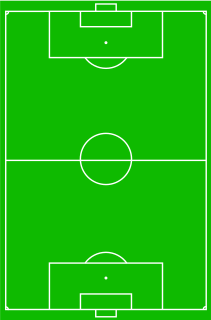
A midfielder is an association football position. Midfielders are generally positioned on the field between their team's defenders and forwards. Some midfielders play a strictly-defined defensive role, breaking up attacks, and are otherwise known as defensive midfielders. Others blur the boundaries, being more mobile and efficient in passing: they are commonly referred to as deep-lying midfielders, play-makers, box-to-box, or holding midfielders. The number of midfielders on a team and their assigned roles depends on the team's formation; the collective group of these players on the field is sometimes referred to as the midfield.

Defence or defense in ice hockey is a player position whose primary responsibility is to prevent the opposing team from scoring. They are often referred to as defencemen, D, D-men or blueliners. They were once called cover-point.
In the sport of association football, a defender is an outfield player whose primary roles are to stop attacks during the game and prevent the opposing team from scoring goals.

Defensive end (DE) is a defensive position in the sport of gridiron football.

In sports, a starting lineup is an official list of the set of players who will participate in the event when the game begins. The players in the starting lineup are commonly referred to as starters, whereas the others are substitutes or bench players.

In American football, the specific role that a player takes on the field is referred to as their "position." Under the modern rules of American football, both teams are allowed 11 players on the field at one time and have "unlimited free substitutions," meaning that they may change any number of players during any "dead ball" situation. This has resulted in the development of three task-specific "platoons" of players within any single team: the offense, the defense, and the so-called 'special teams'. Within these three separate "platoons", various positions exist depending on the jobs that the players are doing.
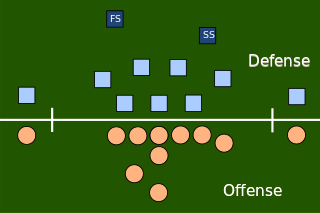
Safety, historically known as a safetyman, is a position in gridiron football which is played by a member of the defense. The safeties are defensive backs who line up from ten to fifteen yards from the line of scrimmage who can play as linebackers or deep as normal safeties. There are two variations of the position in a typical American formation: the free safety (FS) and the strong safety (SS). Their duties depend on the defensive scheme. The defensive responsibilities of the safety and cornerback usually involve pass coverage towards the middle and sidelines of the field, respectively. While American (11-player) formations generally use two safeties, Canadian (12-player) formations generally have one safety and two defensive halfbacks, a position not used in the American game. As professional and college football have become more focused on the passing game, safeties have become more involved in covering the eligible pass receivers.

Tackle is a playing position in gridiron football. Historically, in the one-platoon system prevalent in the late nineteenth and early twentieth centuries, a tackle played on both offense and defense. In the modern system of specialized units, offensive tackle and defensive tackle are separate positions, and the stand-alone term "tackle" refers to the offensive tackle position only. The offensive tackle is a position on the offensive line, left and right. Like other offensive linemen, their job is to block: to physically keep defenders away from the offensive player who has the football and enable him to advance the football and eventually score a touchdown. The term "tackle" is a vestige of an earlier era of football in which the same players played both offense and defense.
Sal Sunseri is an American college and professional football coach who is the outside linebackers coach for the Alabama Crimson Tide of the Southeastern Conference (SEC). Sunseri played college football for the University of Pittsburgh, where he was an All-American linebacker. Sunseri produced at least one Pro Bowl player in four of five seasons as NFL defensive line coach, highlighted by Julius Peppers's three consecutive trips to Hawaii from 2004-2006.

A fullback (FB) is a position in the offensive backfield in gridiron football, and is one of the two running back positions along with the halfback. Fullbacks are typically larger than halfbacks and in most offensive schemes the fullback's duties are split among power running, pass catching, and blocking for both the quarterback and the other running back.
The following terms are used in American football, both conventional and indoor. Some of these terms are also in use in Canadian football; for a list of terms unique to that code, see Glossary of Canadian football.
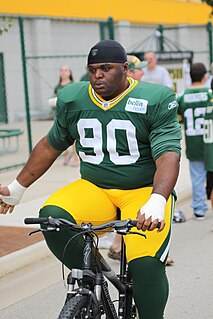
Busari Alamu Raji Jr. is a former American football defensive tackle. He played college football at Boston College. Raji was drafted by the Green Bay Packers with the ninth overall pick in the 2009 NFL Draft. He won Super Bowl XLV with the Packers against the Pittsburgh Steelers.
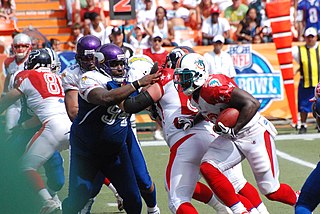
A defensive tackle (DT) is a position in American football that will typically line up on the line of scrimmage, opposite one of the offensive guards, however he may also line up opposite one of the tackles. Defensive tackles are typically the largest and strongest of the defensive players. Depending on a team's individual defensive scheme, a defensive tackle may be called upon to fill several different roles. These roles may include merely holding the point of attack by refusing to be moved, or penetrating a certain gap between offensive linemen to break up a play in the opponent's backfield. If a defensive tackle reads a pass play, his primary responsibility is to pursue the quarterback, or simply knock the pass down at the line if it is within arm's reach. Other responsibilities of the defensive tackle may be to pursue the screen pass or drop into coverage in a zone blitz scheme. In a traditional 4–3 defense, there is no nose tackle. Instead there is a left and right defensive tackle. Some teams, especially in the National Football League (NFL), do have a nose tackle in this scheme, but most of them do not.
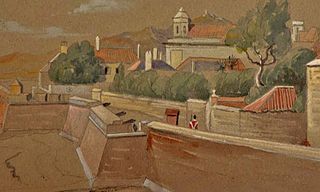
The Line Wall Curtain is a defensive curtain wall that forms part of the fortifications of the British Overseas Territory of Gibraltar.

















